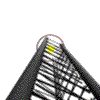 Setting and Correcting SWR
Setting and Correcting SWR 
 Setting and Correcting SWR
Setting and Correcting SWR 
1. Setting the SWR.
Insert the antenna whip 1'' into chrome antenna adjustment mast at the top of the coil. Using either the meter built into the radio or a good external SWR meter, calibrate on channel 20. Switch back to SWR and record the readings on three channels; 1, 20, and 40.
If the lowest SWR reading occurs on channel 1, the antenna whip is to long and must be shortened. Loosen the mast set screws and lower the whip 1/4'' into the mast. Tighten mast set screw and again read SWR. Repeat until lowest SWR is obtained. If the whip is fully lowered into mast and the SWR is still high, remove the whip from mast. Using a hacksaw, grinder, or bolt cutters, cut 1/4'' from the bottom part of the whip. Re-insert the whip into the mast and test again for SWR. Repeat the above procedure until the SWR is below 1.5 of all channels.
If the lowest SWR reading occurs on channel 40, the antenna whip is to short and must be raised. Loosen the mast set screws and raise the whip 1/4'', re-tighten set screws and test SWR again. Repeat the above procedure until the SWR is below 1.5 of all channels.
2. The whip is raised to the top, but the SWR is still lower on CH 40.
This generally occurs on vehicles with very small ground plains, such as the compact cars, cars with hatch-backs, etc. It indicates the need for a longer whip than the standard one supplied.
3. The SWR on a trunk lid mount is 3.0:1 on all channels.
When a reading of 3.0:1 is present on all channels, this indicates a lack of ground for the antenna. For example, some of the vehicles today insulate their trunk lid from the actual chassis or frame, ground of the body. This is done by inserting plastic washers on the trunk hinges, and/or sandwiching a layer of styrofoam type material between the two piece trunk lid. To eliminate this situation, a jumper wire must be installed from the actual bottom lip of the trunk lid to metal on the body of the auto. To accomplish this, loosen one of the hinge bolts on the trunk-lid side and install a braided strap. Re-tighten the bolt. Loosen the bolt on the other side of the hinge (trunk-body side). Install the other end of the braided strap to this bolt and re-tighten. Be sure to leave a long enough loop to prevent pulling apart when the trunk lid is fully open. As added ground insurance, you may wish to add a jumper from the set screw on the trunk lip mount to the hinge bolt on the trunk-lid.
4. If the SWR is good until power is applied:
The antenna is not the problem. In this case, it is the amplifier. You have already established that the antenna is properly tuned and in good working order with low SWR, except when power is applied. Assume a ham operator is on 10 meters using a solid state amplifier. With the radio only, the SWR is 1.1:1; when the amplifier is turned on, the SWR jumps to 2.0:1. The amplifier is not only transmitting at 28 MHz, but is also transmitting on a second frequency of 56MHz. This is known as a ''second harmonic'' (2X the fundamental frequency of 28 MHz, transmitting at 56 MHz). Thus the SWR meter is reading both the reflected signal of the normal frequency and the rejected second harmonic signal. The antenna will not accept energy transmitted at 56 MHz, and returns it all back to the radio, which shows up on the meter as high SWR because the meter can not tell the difference between 28 MHz and 56 MHz. In fact, as much as 30% of the power is at 56 MHz. This is generally due to an amplifier that is not adequately filtered. Adding a Low-pass filter at the amplifier output is the only solution. For best results, connect the low pass filter directly to the amplifier using a barrel connector.
5. How low can the SWR be brought down to?
Ideally it is nice to get the SWR to 1.1:1, but practically a 1.5:1 works just as well. Some installations will not even allow you to achieve a 1.1:1 SWR because of the grounding of the vehicle, the amount of metal available as a ground plane, and other circumstances. However, the loss with a 1.5:1 (using 18' of coax) is actually less than 1/2 of 1% of your output power, which on a normal 5 watt radio means a loss of .025 watts of power. This means that instead of transmitting 5 watts, you are actually transmitting only 4.975 watts. This is not even noticeable at a receiving station. Therefore, spending the extra time to get below 1.5:1 is purely a matter of choice, especially if you have a high performance antenna.
But, what actually happens if your SWR is 2.0:1 instead of 1.5:1 or less? Most CB radios today have protection circuits that starts to shut down (by lowering the output power) when the SWR reaches above 2.0:1. This reduces the output power of the final transistor amplifiers. So generally, anything between 1.5:1 and 2.0:1 is acceptable and useable for good, solid, reliable communications. Readings of 3.0:1 or higher indicates a problem may exist in the system. Check for complete grounding of the system (see #3 above ).